| Gomukha | |
|---|---|
 Gomukha, c. 8th century, Gurjara-Pratihara |
In Jain cosmology, Gomukha is the guardian god or Yaksha (attendant deity) of Rishabhanatha, the first Tirthankara. [1] [2]
| Gomukha | |
|---|---|
 Gomukha, c. 8th century, Gurjara-Pratihara |
In Jain cosmology, Gomukha is the guardian god or Yaksha (attendant deity) of Rishabhanatha, the first Tirthankara. [1] [2]
Gomukha along with Dharanendra is the most popular yaksha in Jainism. [3] [4] [5]
According to Jain tradition, Gomukha is depicted as two or four armed yaksha riding on an elephant. [6] As the name suggests, gomukha has the head of a bull. [7] [8] Gomukha carries a goad in left hand and noose in left. In other two lower arms gomukha carries varada and conch. [9] The yaksha-yakshi pair sculptures of Gomukha-Chakreshwari are one of the most favoured along with Ambika-Sarvanubhuti and Dharanendra-Padmavati. [10] The image of Gomukha yaksha in Ellora caves is noteworthy. [11]

The Dilwara Temples or Delvada Temples are a group of Śvētāmbara Jain temples located about 2+1⁄2 kilometres from the Mount Abu settlement in Sirohi District, Rajasthan's only hill station. The earliest were built by Bhima-1 and supposedly designed or at least financed by Vastupala, Jain minister of Dholka. They date between the 11th and 16th centuries, forming some of the most famous monuments in the style of Māru-Gurjara architecture, famous for their use of a very pure white marble and intricate marble carvings. They are managed by Seth Shri Kalyanji Anandji Pedhi, Sirohi and are a pilgrimage place for Jains, and a significant general tourist attraction. Although Jains built many temples at other places in Rajasthan, the Dilwara temples are believed to be the most impressive.

Padmāvatī is the protective goddess or śāsana devī (शासनदेवी) of Pārśvanātha, the twenty-third Jain tīrthāṅkara, complimenting Parshwa yaksha in Swetambara and Dharanendra in digambar the shasan deva. She is a yakshini of Parshwanatha.
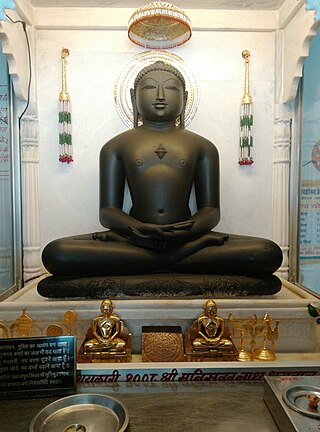
Munisuvrata was the twentieth tirthankara of the present half time cycle (avasarpini) in Jain cosmology. He became a siddha, a liberated soul which has destroyed all of his karma. Events of the Jaina version of Ramayana are placed at the time of Munisuvrata. Munisuvrata lived for over 30,000 years. His chief apostle (gaṇadhara) was sage Malli Svāmi.
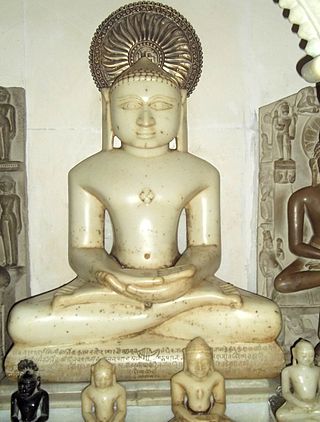
Neminātha, also known as Nemi and Ariṣṭanemi, is the twenty-second Tīrthaṅkara of Jainism in the present age. Neminatha lived 81,000 years before the 23rd Tirthankara Parshvanatha. According to traditional accounts, he was born to King Samudravijaya and Queen Shivadevi of the Yadu dynasty in the north Indian city of Sauripura. His birth date was the fifth day of Shravana Shukla of the Jain calendar. Krishna, who was the 9th and last Jain Vasudev, was his first cousin.
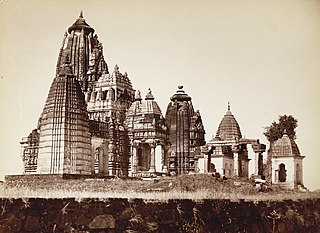
The Jain temples of Khajuraho are a part of the UNESCO World Heritage Site of Khajuraho. They are located in Chhatarpur district, Madhya Pradesh, India, about 175 kilometres southeast of the city of Jhansi.
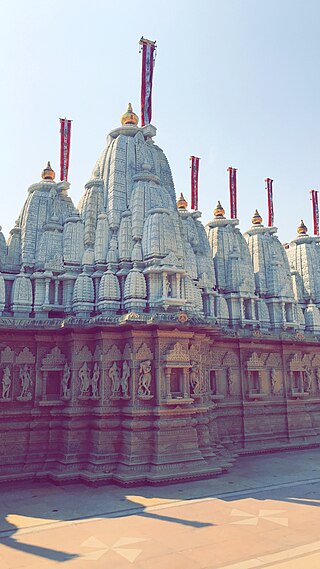
The Shankheshwar Jain Temple is located in the center of Shankheshwar town of Patan district, Gujarat, India. The temple is dedicated to Parshwanath and is an important place of pilgrimage for the followers of Jainism.

In Jainism, Ambika or Ambika Devi is the yakshini "dedicated attendant deity" or Śāsana Devī "protector goddess" of the 22nd Tirthankara, Neminatha. She is also known as Ambai, Amba, Kushmandini and Amra Kushmandini. She is often shown with one or more children and often under a tree. She is frequently represented as a pair with a small Tirthankar image on the top. The name ambika literally means mother, hence she is Mother Goddess. The name is also a common epithet of Hindu Goddess Parvati.

Jain sculptures or Jain idols are the images depicting Tirthankaras. These images are worshiped by the followers of Jainism. The sculpture can depict any of the twenty-four tirthankaras with images depicting Parshvanatha, Rishabhanatha, or Mahāvīra being more popular. Jain sculptures are an example of Jain art. There is a long history of construction of Jain sculptures. Early examples include Lohanipur Torsos which has been regarded to be from the Maurya period, and images from the Kushan period from Mathura.

The Akota Bronzes represent a rare and important set of 68 Jain images, dating to between the 6th and 12th centuries AD, which were found in the vicinity of Akota near Baroda in the Indian state of Gujarat. It includes rare Gupta period bronzes that have been widely used for comparison of Gupta period art.
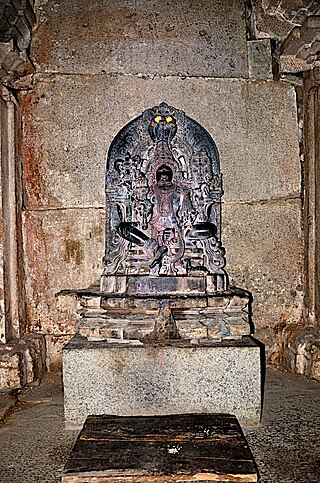
Dharanendra is the Yaksha of Parshvanatha, twenty-third Tirthankara in Jainism. He enjoys an independent religious life and is very popular amongst Jains. According to the Jain tradition, when Parshvanatha was a prince, he saved two snakes that had been trapped in a log in an Kamath’s fire. Later, these snakes were reborn as Dharanendra, the lord of the underworld Naga Kingdom, and Padmavati. They, then sheltered Parshvanatha when he was harassed by Meghalin. Śvētāmbara tradition, however, does not list Padmavati among the main queens of Dharanendra.

Adinatha temple is a Jain temple located at Khajuraho in Madhya Pradesh, India. It is dedicated to the Jain tirthankara Adinatha, although its exterior walls also feature Hindu deities. This temple is part of UNESCO World Heritage Site along with other temples in Khajuraho Group of Monuments.

Jain Basadi complex in Halebidu, Hassan district consists of three Jain Basadis dedicated to the Jain Tirthankars Parshvanatha, Shantinatha and Adinatha. The complex is situated near Kedareshwara temple and Dwarasamudra lake. These temples were constructed in the 12th century during the reign of Hoysala Empire along with Kedareshwara temple and Hoysaleswara Temple have been proposed to be listed under UNESCO World Heritage Site. The temple complex also includes a step well called Hulikere Kalyani.

Jivantasvami images represent the Jain Tirthankara Mahavira as a prince, with a crown and ornaments. The Jina is represented as standing in the kayotsarga pose. Jivantasvami images have been used only in the Shvetambara Jain tradition, they are unknown in the Digambara tradition.
In 1956, 240 Jain bronze idols were discovered dating back to early medieval to medieval period. The Vasantgarh hoard, thus named after the place of discovery, Vasantgarh is located in the Sirohi District of Rajasthan, India.
Panchasara Parshwanath temple is a Jain temple located in Patan, Gujarat. The temple was constructed in 8th century during the reign of Vanaraja Chavda of Chavda dynasty.

The Kumbharia Jain temples is a group of five Jain temples in the Kumbhariya, Banaskantha district in Gujarat, India. Constructed from 1062 to 1231 CE during the reign of the Chaulukya dynasty, they are noted for their elaborate architecture.

The Humcha Jain temples or Humcha basadis are a group of temples found in Humcha village of Shimoga district in Karnataka, India. They were constructed in the 7th century CE in the period of the Santara dynasty and are regarded as one of the major Jain centres of Karnataka. The Padmavati Basadi is the most well-known of these temples.

Pakbirra Jain temples is a group of three Jain temples in Pakbirra village in Purulia district of West Bengal.

The Ahichchhatra Jain temples is a group of Jain temples in Ahichchhatra village in Aonla tehsil of Bareilly district in Uttar Pradesh, North India. Ahichchhatra is believed to be the place where Parshvanatha, the 23rd Tirthankar of Jainism, attained Kevala Jnana.

Danavulapadu Jain temple is an ancient Jain center located in Danavulapadu village of Kadapa district in the state of Andhra Pradesh.